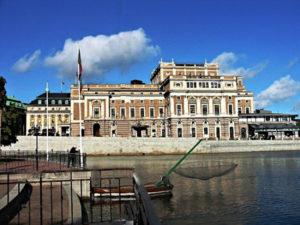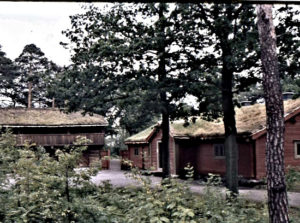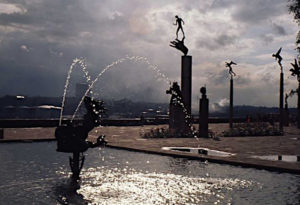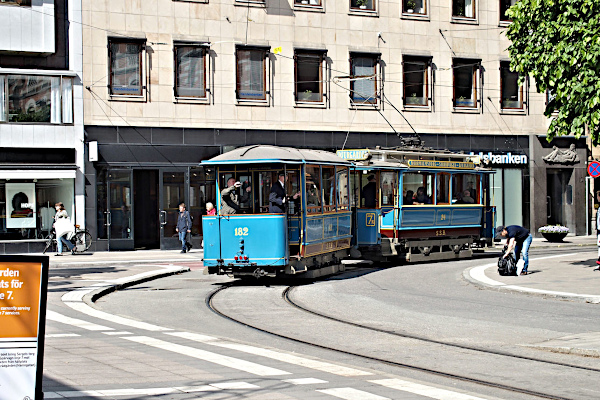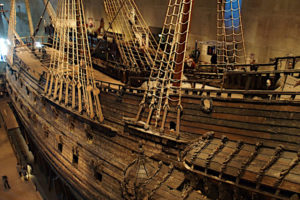Chapter 24 (Part 2) — Stockholm and some history
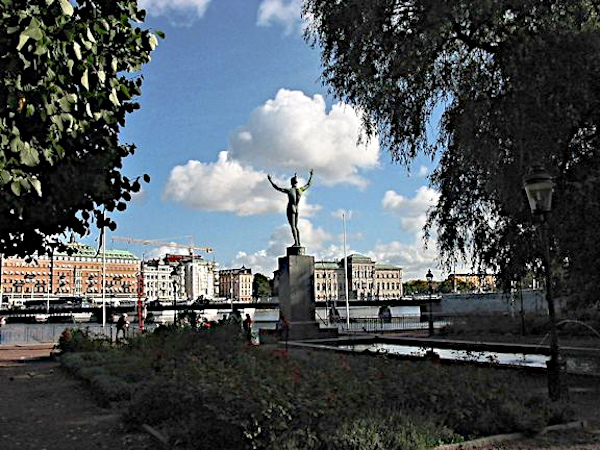
Carl Milles’ Solsångaren (Sun Singer) on Strömparterren below Norrbro, , in front of the Royal Palace.
I do believe Stockholm is unique among all the capitals of the world. Beauty is obviously a subjective thing, but a city built on islands close to 1000 years ago and then growing to the north and south but still having for many centuries as much water as land surface, must be considered pretty much exceptional. On a sunny day Stockholm is a jewel of water and glowing façades, the sun gleaming on the beautiful old buildings and the ripples on the water.
ngg_shortcode_0_placeholder” order_by=”sortorder” order_direction=”ASC” returns=”included” maximum_entity_count=”500″]
The street called Strandvägen is one of my favorite strolling places in Stockholm. On one side you see the most patrician old apartment buildings in all of Sweden and on the other side is the water with the mooring bollards for fishing boats and now also an ever increasing number of tourist boats.
In the 21st century, however, or even long before, there have been no cars parked along the side on Strandvägen. Which definitely dates the picture below.
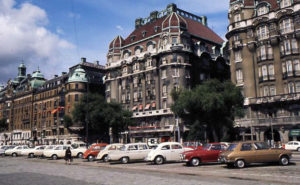
In a way the most elegant street in Stockholm from the beginning of the 20th century — Strandvägen.(1971)
In between is the heavily tree-lined walking alley. This street takes you down to a bridge, Djurgårdsbron, leading to Djurgården, an island that has its very own history and beauty. And it also has wonderfully pleasant places in a forest to wander around in.
I lived in or close to this beautiful city for four years around 1960, but I have rarely appreciated the city as much as with John. Who was the guide, he or I? John was definitely the driver when we moved from one suburb across the city (or in fact across Västerbron) to another suburb to visit friends.
During the summer of 1971, the first time John and I visited Sweden, we of course went to Stockholm, and John also got to know this beautiful city and even quite a few friends. Stockholm sits on several islands on Lake Mälaren. Gamla stan, the Old Town, with the Royal Palace, is the oldest one of all these islands but there are several other islands that are part of the city. Of course the major parts of Stockholm have long been on the mainland north and south and east of the original islands.
There are some places in our capital that are exceptional and I remember Mother showing my sister Gun and me around Stockholm when we were still in high school. Gun was confirmed in 1946 (Don’t ask me why – we did those things because our friends did, I think.) by an old childhood friend of Mother’s who was now a vicar in a town called Eskilstuna close to Stockholm. Gun spent the summer with his family and I and Mother picked mushrooms off the asphalt sidewalks in Malmö. At the end of the summer Mother and I went to Eskilstuna to see Gun get confirmed and afterwards we continued up to Stockholm to make our first acquaintance with our capital.
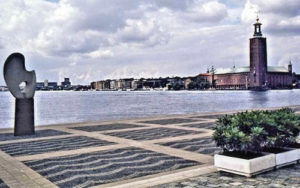
The Stockholm City Hall seen from Riddarholmen. The sculpture on Evert Taube’s Terrace here is “Sun Boat”by Christian Berg.
It’s amazing to realize how enterprising and healthy Mother was at that time. There was of course no metro in those days, but Mother took us around the city by streetcar and bus. And we walked a lot of course, the way you still have to, if you want to really get to know a big city, be it London, Berlin, Prague or Istanbul.
Arne wasn’t even with us but Mother showed us around all the most see-worthy places in Stockholm, as if she gad grown up in the city. There was Stadshuset, the City Hall with ‘den gyllene salen‘, the Golden Hall with its fabulous mosaics, It was so huge I felt awed as I was looking up into the far-away ceiling.
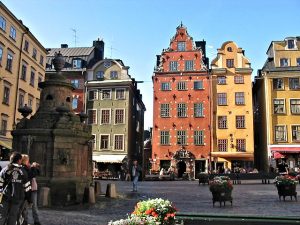
Gamla stan – the Old Town with its Hanseatic buidings — and Stortorgsbrunnen, an old water fountain, actually a real old well.
There was Gamla Stan, “the Old Town”, and Storkyrkan, the Stockholm Cathedral, with the famous statue of “Saint George and the Dragon”, “Sankt Göran och draken“, made in wood and dating from the 15th century. Storkyrkan dates from the 13th century and, according to tradition, was originally built by Birger Jarl, the Jarl (earl) of Sweden in the 13th century and the founder of the city itself. I remember well standing at the foot of this impressive statue with Mother and looking up in awe. We were learning about history first-hand. [1. Contrary to what one reads about ‘the first king’ of Sweden, Birger Jarl and other following statesmen were not kings. The first Swedish king was Gustav Vasa who declared himself king and was crowned in 1523, two years after becoming the earl of Sweden. (riksföreståndare)]
We went on a tour of the huge rooms inside the Royal Palace which is right next to Storkyrkan and we marveled at the splendid interiors. We watched the change of the Guard (Vaktparaden) on Slottsgården behind the main buildings.
We were standing facing the Royal Palace, Mother, Gun and I, by the bridgehead of Norrbro (the northern bridge). Gustav Adolf’s Torg, the big plaza and the very center of old Stockholm, was behind us. When we turned around we saw the elegant Royal Opera building on the eastern side and the Palace of the heir to the throne (Arvfurstens palats) on the western side of the plaza. The equestrian statue of Gustav II Adokf in the center dominates the plaza.
Norrbro is the bridge that connects “the Old Town”, Gamla Stan with Norrmalm, the northern mainland. I was looking down at the strange-looking huge nets attached to quite a number of fishing boats moored on the side of the bridge. All fascinated, I looked down into the eternally swirling eddies on the water at this place, which is called Strömmen, or more exactly Norrström, the North Stream. It seemed as if witches were stirring the water with enormous ladles, as in a witch’s brew.
The eddies on the water, the Royal Palace and Gustav II Adolf on his horse in the center of the plaza have not changed, and on the little island, Strömparterren, partly under the bridge, there was already in those days a graceful statue that adds to the beauty of this little island. The world famous sculptor Carl Milles created this beautiful bronze statue, Solsångaren, the Sun Singer, which has replicas in several cities of the world.
From here you can look far out over Strömmen to Blasieholmskajen, the water front off Grand Hotel, the National Gallery. Skeppsholmen (the ships’ island) can vaguely be seen on the right.
ngg_shortcode_1_placeholder” order_by=”sortorder” order_direction=”ASC” returns=”included” maximum_entity_count=”500″]
There was Kungsgatan and Stureplan (amazing how all is changed today!), NK (Nordiska Kompaniet), the big department store on Hamngatan, the central commercial areas of Stockholm with an endless number of luxury stores all around Norrmalmstorg. That plaza is where you often changed streetcars and it is close to the Royal Dramatic Theater, usually called Dramaten, and Nybroviken, the mooring place for all sorts of boats in this bay of Lake Mälaren. That is also the beginning of my beloved Strandvägen. All these plazas and streets together were the “downtown” of Stockholm in my days. It has now more or less been replaced by Sergels Torg, which is right over the central metro station, T-Centralen (T for tunnelbana).
Mother was a miracle of youth, energy and enthusiasm when she showed us around all these wonderful sites during our few days in Stockholm. We got a wonderful first introduction to this big city with its most outstanding monuments, the extraordinary beauty of the city on Lake Mälaren with its innumerable islands
From the eastern edge of the Old Town, on Skkepsbron, which smells of tar and sea water and is spotted with bollards for mooring various boats, Mother, Gun and I took the ferry to Djurgården (Animal Garden), so called because it became it was a royal hunting ground after Gustav Vasa confiscated the island from the Catholic church. Gustav Vasa objected to the Pope having any power whatsoever over Sweden and introduced Lutheran Protestantism into the country. He certainly also wanted access to the wealth of the Catholic church, and he got it. Djurgården was opened to the public in the 18th century.
On Djurgården there is Gröna Lund, the amusement park, which was a lot of fun, and, above all, there is Skansen, the internationally known open-air cultural museum. I now know, however, that Djurgården is also still covered by woods and winding paths where you can take long peaceful walks without any interference from the noise of modern electronic bang-bang or polluting vehicles.
ngg_shortcode_2_placeholder
Skansen is the oldest museum of its kind in the world, and there is also a beautiful little zoo for Swedish animals. Mother, the supreme animal lover, delighted in showing us the deer, ducks and geese in a big pond and whatever else there was — and is. Skansen is a historic Sweden in miniature with old low-ceilinged houses and bigger buildings, such as the Seglora wooden church (from Seglora in Västergötland in 1918), buildings that were moved to this museum from all over Sweden. And here you soak in the beauty and you can also learn about arts and crafts, about how people lived and worked in past centuries in our country
In 1971 John and I, on our very first visit to Sweden together, went to the wonderful Millesgården on Lidingön, another Stockholm island – a gorgeous outdoor museum that is devoted exclusively to the famous sculptor, Carl Milles (1875-1955).
ngg_shortcode_3_placeholder” order_by=”sortorder” order_direction=”ASC” returns=”included” maximum_entity_count=”500″]
We did not see this museum with Mother since it was not at that time the outstanding attraction that it has since become. Ever since its opening to the public in 1936 it has kept changing and growing. Today you will find most of Milles’ most important sculptures in this park, and there are replicas all over the world, The Metropolitan Museum in New York City among other places has, for instance, the Fountain of the Muses and you can admire it while you have lunch in their outdoor restaurant.
However, for the past few decades the main source of attraction for tourists has been the Vasa ship and its museum on Djurgården. John and I saw it when it was still being watered day and night, in 1971, and the hall where it was while undergoing restoration work was all steamy and clammy. It’s the only ship in the world that still remains today from as far back as the 17th century.
It was then called Vasavarvet, the Vasa shipyard, and shortly afterwards the museum was built around it so it would become a place where people from all over the world co to see this amazing relic from the past. The museum opened in 1990, and people can now see from three levels this majestic piece of history, the Vasa ship that sank on its maiden voyage in 1628 after sailing less than a nautical mile. We finally got to see this fabulous museum in May 2016, on our latest visit to Stockholm with our nephew Måns.
Måns came up from Linköping and spent a wonderful sunny Sunday with us. In fact he invited us to everything at the Vasa Museum.
It also so happened that it was “Spårvägens dag”, “the Day of the Streetcar”, and both Måns and I just love old streetcars. We were sitting in Norrmalmstorg (the main Plaza of the northern mainland — Stockholm is not all built on islands), the very center of Stockholm where I have changed streetcars innumerable times. I got a good laugh when we saw a streetcar from the years I used to live in or close to Stockholm, in the early sixties, and it was old even at the time. This streetcar was now history, but there were of course later ones too, the kind that came in when I lived there.
ngg_shortcode_4_placeholder” order_by=”sortorder” order_direction=”ASC” returns=”included” maximum_entity_count=”500″]
Back to the Vasa ship. It seems like an engineering and archeological miracle having managed first to lift the 300-year-old wreck from the bottom of the sea and then to restore this product of the megalomania of King Gustav II Adolf, the grandson of Gustav Vasa. He was all set on making Sweden into a great power, a goal which he realized through the 30 years’ war. He insisted on using the new ship Vasa in the naval war against Poland. He was told by his counselors that it was not seaworthy, but he steadfastly insisted on taking it to the war arena. The rest is well-known history about how Gustav II Adolf himself was killed in the bloody battle of Lützen in 1632 [3. When I was in high school, every 6 November, the day of Gustav Adolf’s death, was celebrated in an assembly with the school chorus singing the hymn to Gustav Adolf, the Swedish warrior hero “Heroes that pray, fight and bleed … their strength as always coming from God”, etc. I hope such patriotic nonsense was given up long ago. Fake hero worship is among the worst propaganda means that can undermine the lucidity of a people.]
Sweden as a great power did not last long though. “We” actually once took over important parts of northern Germany and Poland along the coast of the Baltic. However, Karl XII who, like Napoleon, tried to invade and conquer Russia under Peter the Great, overdid everything he tried to accomplish. The poor Swedish soldiers, all from the lowest peasant and working class families, suffered and died in masses. Of course he lost that war. But that wasn’t enough for Karl. He opened a new front on Denmark-Norway (at that time one country) and in 1718 he was killed by a very much debated bullet in Halden outside Oslo. The big question was which side the bullet came from. And was it actually a button from a uniform, as has been theorized? It has, however, been pretty well established that the bullet came from the Swedish side, so it was a form of mutiny. The Swedish Empire crumbled. [4. Charles XII ascended the throne at the age of 15 in 1697. The several states surrounding the Baltic allied to keep this sea, extremely important for trade, from becoming totally dominated by Sweden. Charles, after having beaten the Danes and several states in the east of Germany and Poland, realized that the Russians were now the one enemy left to defeat. And so began the disastrous Russian war 1707 – 1709.]
I can never get too much of Stockholm. I love it. But, as I said when talking about Copenhagen, there is one important thing missing in Stockholm. There is none of the wonderful Gemüt in our capital that Copenhagen is so well-known and well loved for.
Continued: Chapter 25 – Ecole Centrale and great friends in Paris

